Of all the developments that stimulated the growth of Fort Worth during its first century—beginning with establishment of the Army fort itself, of course, then the cattle drives, the railroads, the stockyards and packing plants, the oil boom, and the bomber plant/airbase—today the stockyards and packing plants, although reduced to a few relics today, are the most tangible, the most accessible.
Cowtown, having been first a cattle trail town and then a railroad hub, was a natural location for a stockyards and packing plants. And by one estimate, by 1890 there were one million head of cattle within one hundred miles of Fort Worth.
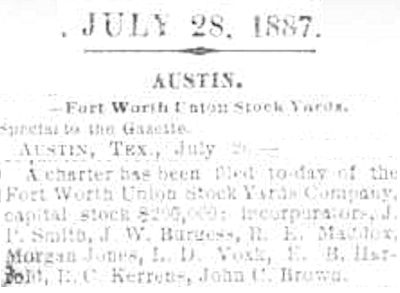 So, in July 1887 a group of local civic leaders, including John Peter Smith, created the Fort Worth Union Stock Yards Company and bought land north of town.
So, in July 1887 a group of local civic leaders, including John Peter Smith, created the Fort Worth Union Stock Yards Company and bought land north of town.
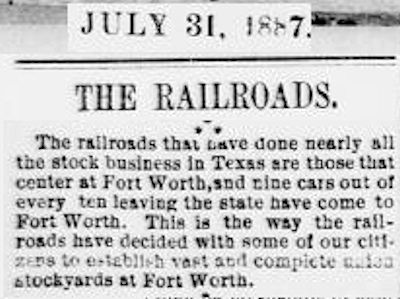 The Fort Worth Gazette pointed out that “nine [railroad] cars out of every ten leaving the state have come to Fort Worth.” The railroads, such as Santa Fe, first encouraged and then invested in Fort Worth’s original stockyards.
The Fort Worth Gazette pointed out that “nine [railroad] cars out of every ten leaving the state have come to Fort Worth.” The railroads, such as Santa Fe, first encouraged and then invested in Fort Worth’s original stockyards.
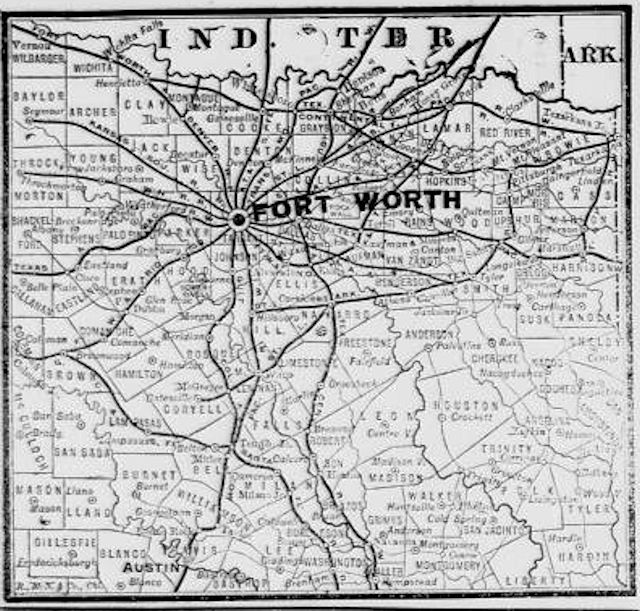 Every edition of the Gazette included this map showing the railroads serving Fort Worth. (That map also shows some railroads that did not yet serve or never served Fort Worth.)
Every edition of the Gazette included this map showing the railroads serving Fort Worth. (That map also shows some railroads that did not yet serve or never served Fort Worth.)
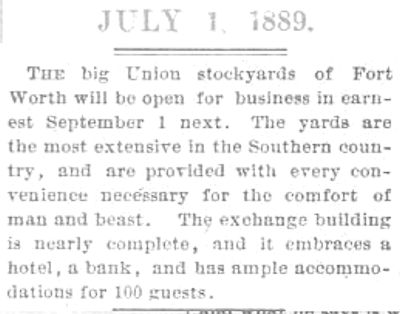 By July 1, 1889 the Union Stockyards was almost completed.
By July 1, 1889 the Union Stockyards was almost completed.
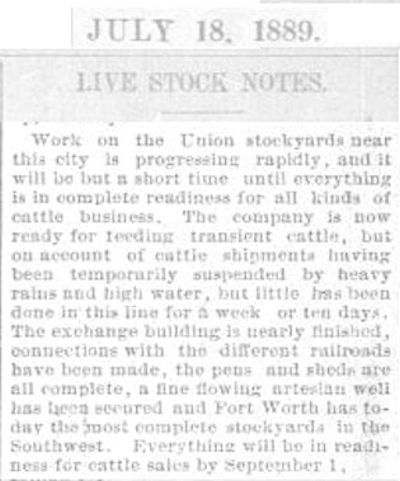
On July 18 the Gazette reported that the stockyards was almost ready for business despite delays caused by rain. The exchange building was nearly finished; railroad connections had been made; an artesian well had been dug.
 In fact, the next day the Gazette wrote, “It can be considered that the yards are now open for business of all kinds.”
In fact, the next day the Gazette wrote, “It can be considered that the yards are now open for business of all kinds.”
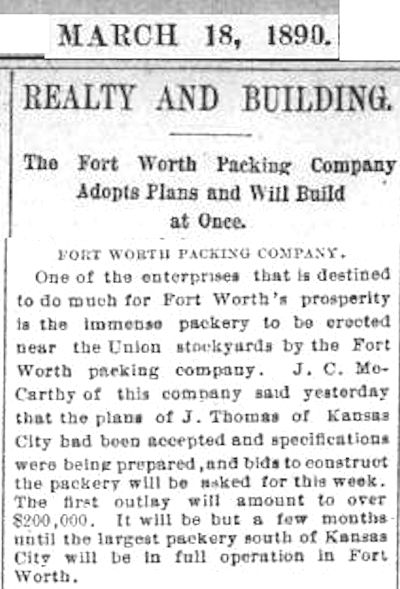
A natural complement to the new stockyards would be a packing plant. In March 1890 plans were announced for “the largest packery south of Kansas City.” Among organizers of Fort Worth Packing Company was North Side civic leader M. G. Ellis.
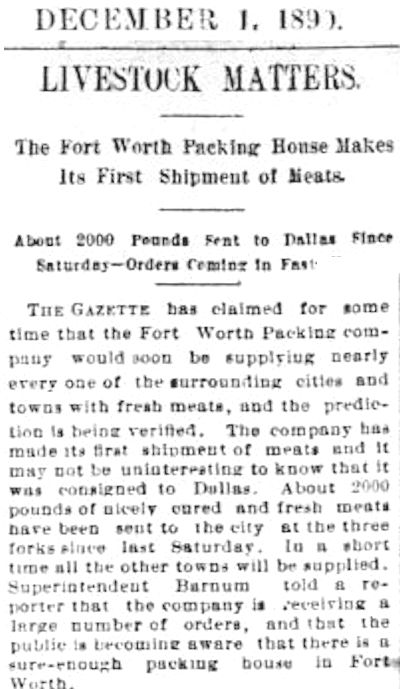 The packing plant on November 29, 1890 made its first shipment of meat—to Dallas.
The packing plant on November 29, 1890 made its first shipment of meat—to Dallas.
But the new packing plant soon needed money to expand. Local businessman Michael C. Hurley went east to seek investors. As a result, Boston capitalist Greenlief Wadleigh Simpson came to Fort Worth to inspect the two operations.
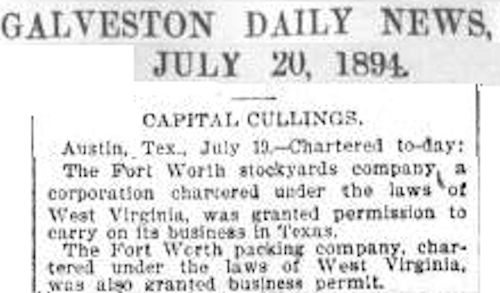 In 1893 Simpson and Louville Veranus Niles and other eastern capitalists formed Fort Worth Stock Yards Company and bought the Union Stockyards and the original Fort Worth Packing Company. In West Virginia, where the law was more favorable, the syndicate chartered the two companies to build and operate a new stockyards and a new packing plant in Fort Worth.
In 1893 Simpson and Louville Veranus Niles and other eastern capitalists formed Fort Worth Stock Yards Company and bought the Union Stockyards and the original Fort Worth Packing Company. In West Virginia, where the law was more favorable, the syndicate chartered the two companies to build and operate a new stockyards and a new packing plant in Fort Worth.
But Simpson and Niles soon wanted more. The nation’s biggest meatpacking companies, Swift and Armour, were headquartered in Chicago. In 1901 Simpson and Niles, with the full support of Fort Worth civic leaders, began negotiating with Swift and Armour, hoping to lure just one of the giants. Simpson and Niles offered Swift and Armour land adjacent to their stockyards on which to build packing plants. The city of Fort Worth promised each packer $50,000 ($1.4 million today) to build in Fort Worth. Simpson and Niles agreed even to give each packer one-third of the men’s personal interest in Fort Worth Stock Yards Company.
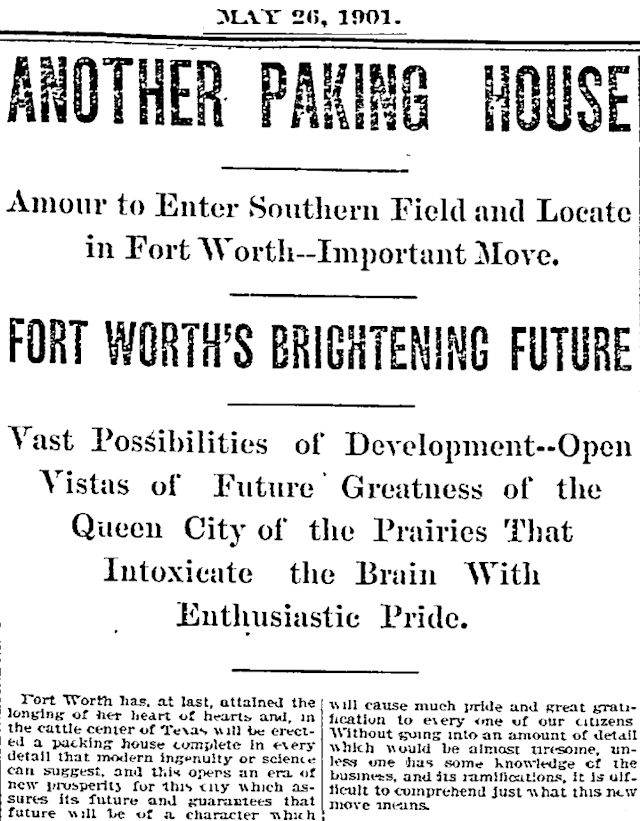 All that financial seduction paid off. On May 26, 1901 the Fort Worth Register crowed that “Amour” was coming to town. “Open Vistas . . . Intoxicate the Brain,” the Register swooned. “Fort Worth has, at last, attained the longing of her heart of hearts.” Editors could scarcely contain their rapture; proofreaders apparently took the day off to celebrate. The “Another” in “Another Paking House” refers to the existing Simpson-Niles packing plant.
All that financial seduction paid off. On May 26, 1901 the Fort Worth Register crowed that “Amour” was coming to town. “Open Vistas . . . Intoxicate the Brain,” the Register swooned. “Fort Worth has, at last, attained the longing of her heart of hearts.” Editors could scarcely contain their rapture; proofreaders apparently took the day off to celebrate. The “Another” in “Another Paking House” refers to the existing Simpson-Niles packing plant.
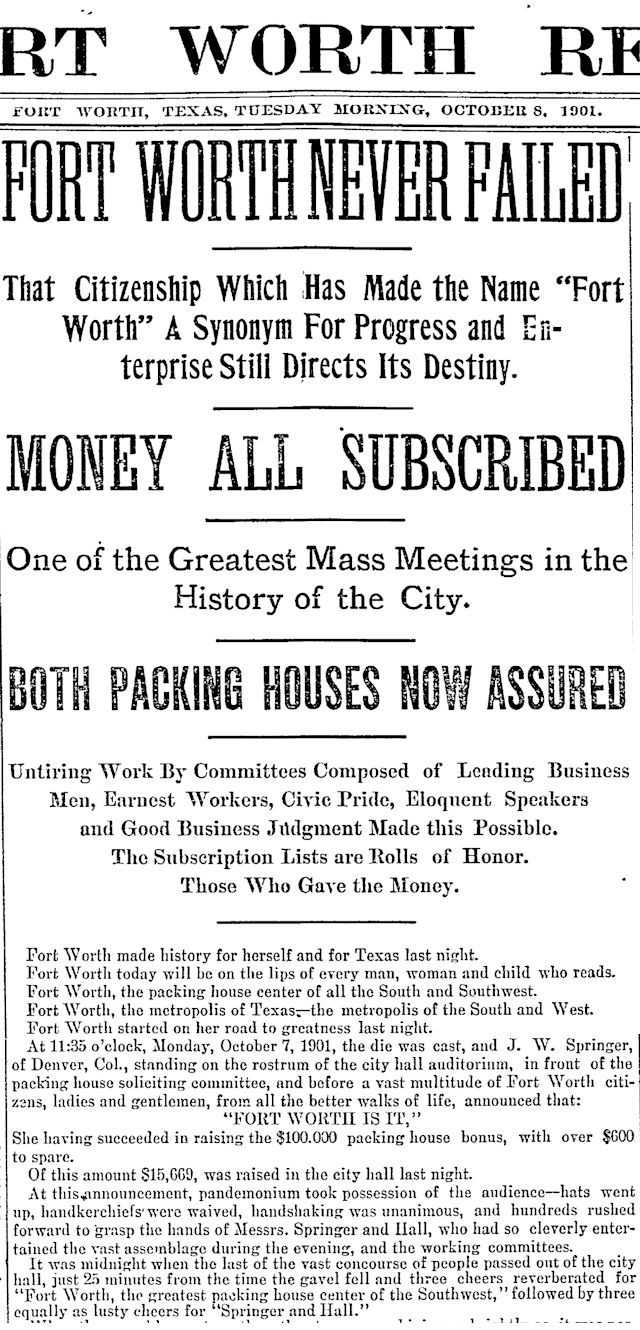 Five months later, on October 8, 1901, with “Fort Worth Never Failed,” the Register announced that Fort Worth had raised the $100,000 incentive money to secure both packing plants. “Three cheers reverberated for ‘Fort Worth, the greatest packing house center of the Southwest.’”
Five months later, on October 8, 1901, with “Fort Worth Never Failed,” the Register announced that Fort Worth had raised the $100,000 incentive money to secure both packing plants. “Three cheers reverberated for ‘Fort Worth, the greatest packing house center of the Southwest.’”
 And, indeed, in December of 1901 the Fort Worth Stock Yards Company ratified the agreements with Armour and Swift for the construction of two packing plants in Fort Worth.
And, indeed, in December of 1901 the Fort Worth Stock Yards Company ratified the agreements with Armour and Swift for the construction of two packing plants in Fort Worth.
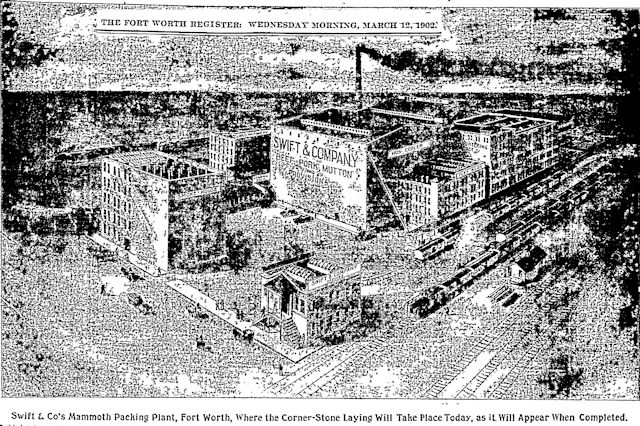
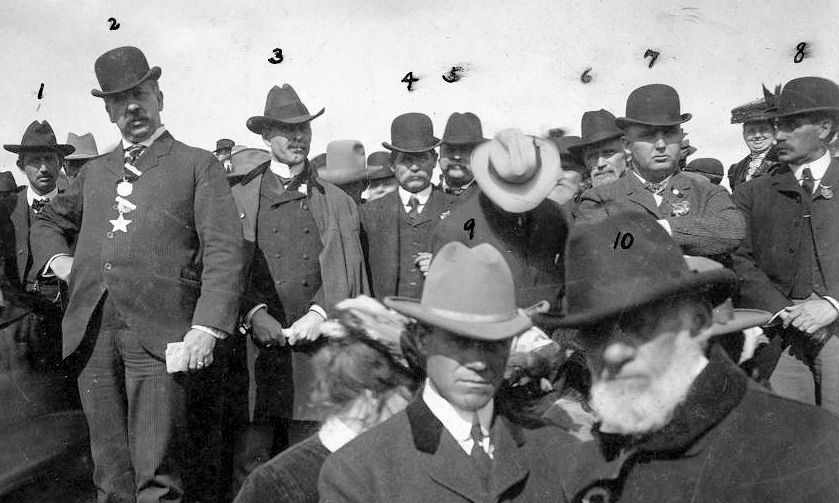
The cornerstone-laying ceremony for the two packing plants took place on March 12, 1902. People identified with numbers above their heads: 1. Board of Trade vice president Dr. J. L. Cooper, 2. Board of Trade president Paul Waples, 3. unidentified, 4. alderman Tom Murray, 5. alderman B. L. Waggoman, 6. Police Chief William Rea, 7. city waterworks superintendent Hugh L. Calhoun, 8. banker W. G. Newby, 9. cattleman and planter Van Zandt Jarvis, 10. civic leader J. J. Jarvis. (Photo from University of Texas at Arlington Library.)
 The two plants opened on March 6, 1903. At that time, two thousand people worked at the two packing plants and the stockyards. That number was expected to more than double within five years. One packing house official said on that day, “I look for a population of 75,000 for Fort Worth within the next five years.” Fort Worth’s population in 1903 was 35,482. The prediction was not far wrong: Fort Worth’s population in the 1910 census would be 73,312.
The two plants opened on March 6, 1903. At that time, two thousand people worked at the two packing plants and the stockyards. That number was expected to more than double within five years. One packing house official said on that day, “I look for a population of 75,000 for Fort Worth within the next five years.” Fort Worth’s population in 1903 was 35,482. The prediction was not far wrong: Fort Worth’s population in the 1910 census would be 73,312.

On May 15, 1903 the Telegram announced that the first “solid train of fresh meat” had left the packing plants bound for ten states.
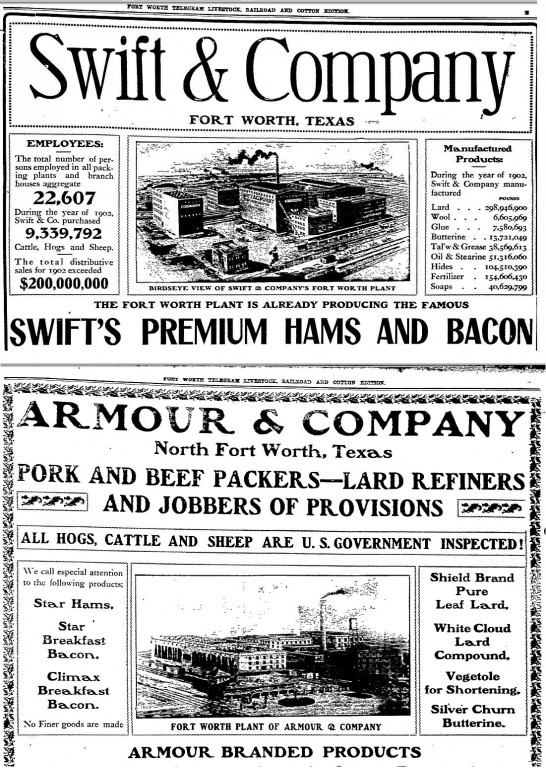
Indeed, the packing plants created a population boom in greater Fort Worth, led to the creation of the cities of North Fort Worth and Niles City. What today is the North Side became a polyglot melting pot. Speculators like Sam Rosen rode the boom to wealth. And with the increase in industry came an increase in pollution of the Trinity River.
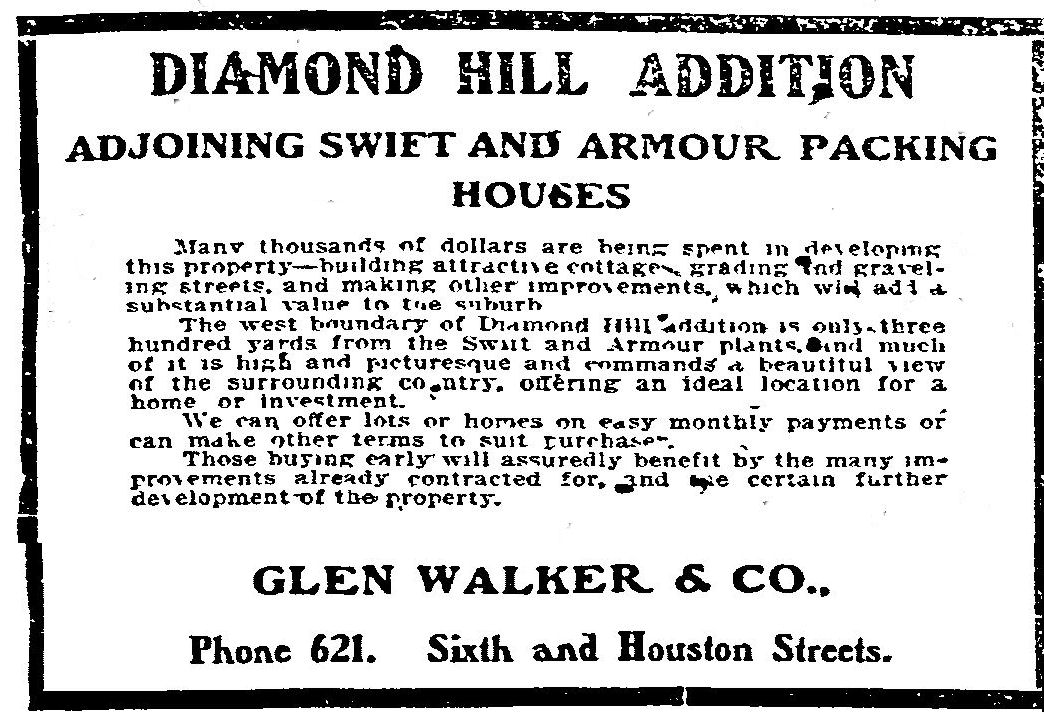 Diamond Hill was part of the boom in 1903.
Diamond Hill was part of the boom in 1903.
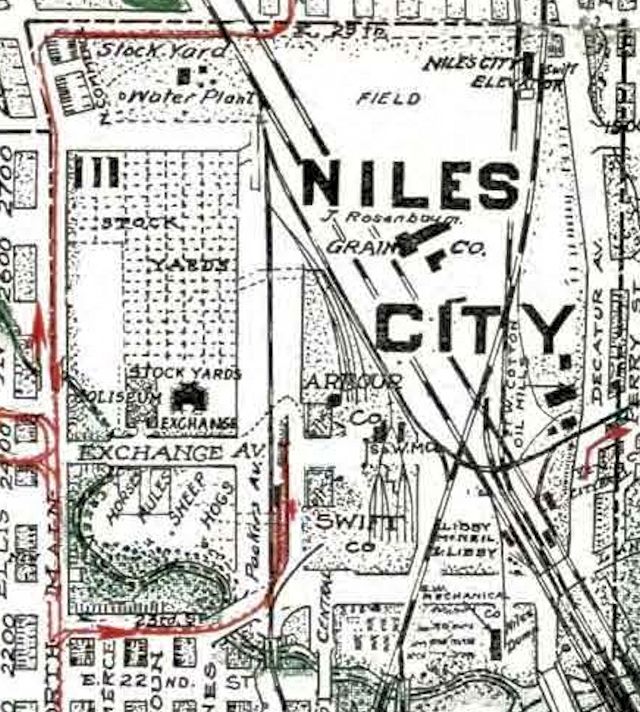 Niles City (incorporated 1911; named for stockyards principal Louville Niles), the tiny enclave that enclosed the stockyards and packing plants, was called “the richest city in the world” because of the big assets in its small area. (Map detail from Pete Charlton’s “1000+ Lost Antique Maps of Texas & the Southwest on DVD-ROM.”)
Niles City (incorporated 1911; named for stockyards principal Louville Niles), the tiny enclave that enclosed the stockyards and packing plants, was called “the richest city in the world” because of the big assets in its small area. (Map detail from Pete Charlton’s “1000+ Lost Antique Maps of Texas & the Southwest on DVD-ROM.”)
Suddenly, with two major packing plants and the stockyards, North Fort Worth was calling itself the “Chicago of the Southwest.” In 1907 the Telegram reported that the population of North Fort Worth had exploded from two hundred in 1902 to ten thousand. Swift and Armour, like the stockyards, were major employers. For decades the stockyards and packing plants were “the office” to as many as five thousand workers.
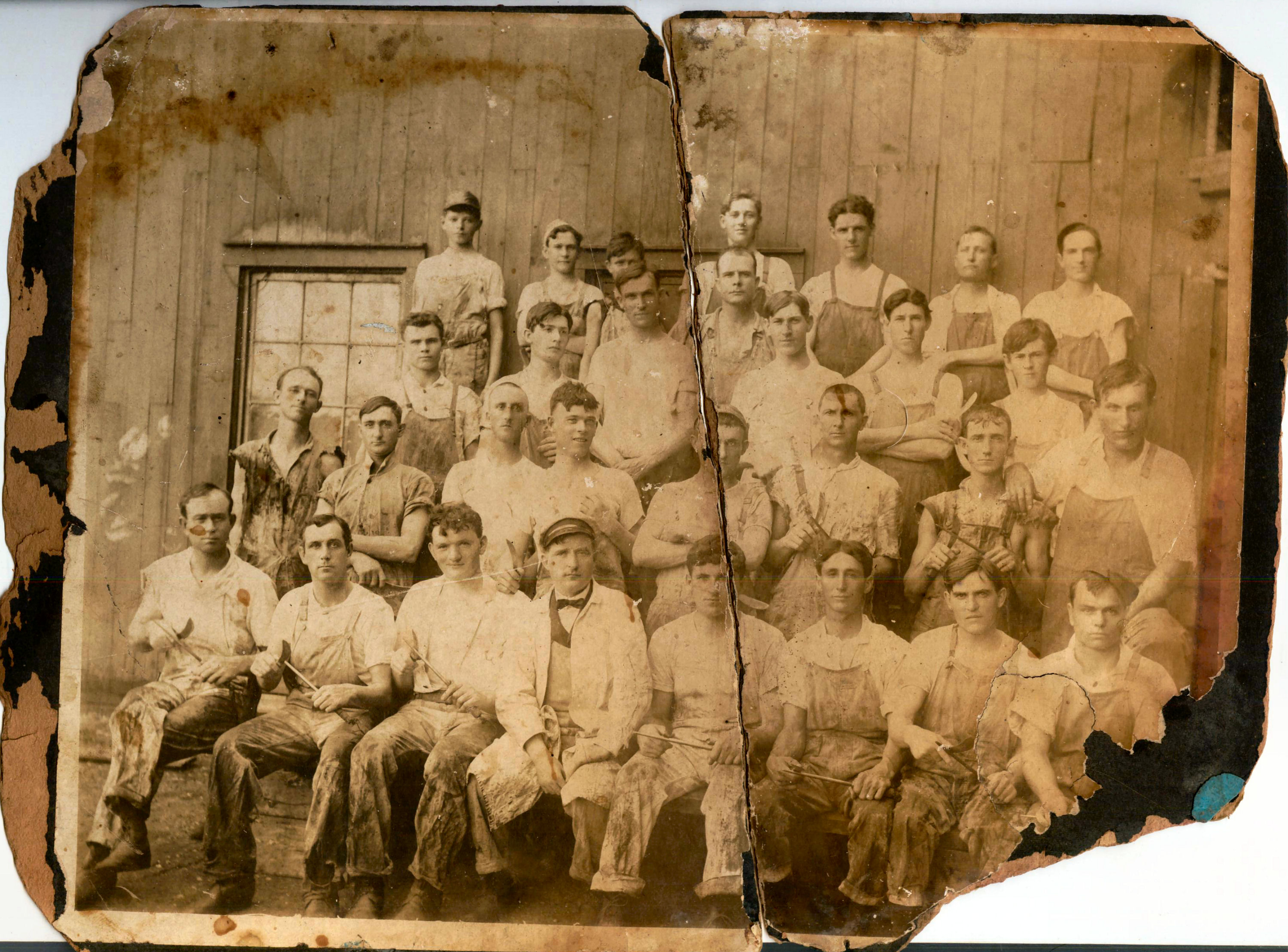 My family was probably typical. Among the early wave of workers was my grandfather (second row from bottom, far left), who worked at Swift in 1908.
My family was probably typical. Among the early wave of workers was my grandfather (second row from bottom, far left), who worked at Swift in 1908.

A generation later, in the ’40s and ’50s my father worked at the stockyards, my mother at “the packin’ plant.” By then my grandfather was working at Bluebonnet, a smaller packing plant on the North Side.
 “The office” for thousands of employees in the 1930s. (Photo from Tarrant County College Northeast, Heritage Room.)
“The office” for thousands of employees in the 1930s. (Photo from Tarrant County College Northeast, Heritage Room.)
 W. D. Smith photos from 1940.
W. D. Smith photos from 1940.
Fort Worth Stockyards Company, at its peak in 1944, sold five million head of livestock. But in the 1950s the big central operation began to face competition from local auctions and cattle feedlots. Cattle raisers began to move stock by truck, meaning that railroads were not necessary, which in turn meant that a packing plant could be built anywhere. The big packing plants suddenly had to compete with smaller, more efficient packers.
After Armour closed in 1962 and Swift in 1971, the stockyards area declined. But then the area, originally a gritty, organic place with a decidedly low glamour factor, reinvented itself and acquired a certain cowhide cachet as a tourist attraction. Today it’s the “Cow” in “Cowtown,” the one place in town where you are most likely to see bikers and cowboys belly up to the same bar,
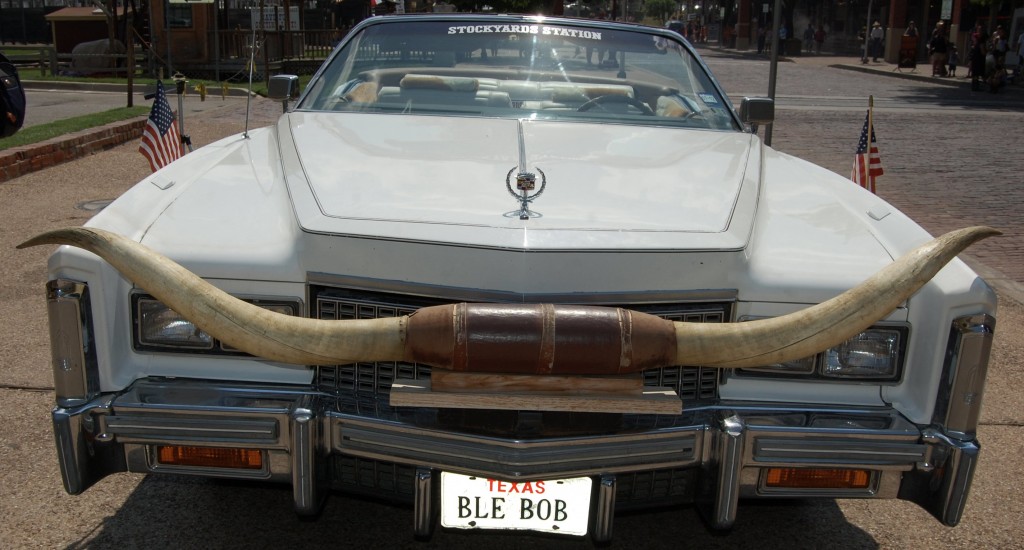
to see longhorns on a Cattleac,

or on a (get along, little) doggy, or to hear a couple speaking German or Japanese as they ponder the difference between a bull and a steer.
And, of course, it’s the only place in town to see a Longhorn cattle drive. The stars of the show backstage:
It’s showtime:
Some views of the stockyards-packing plants complex:
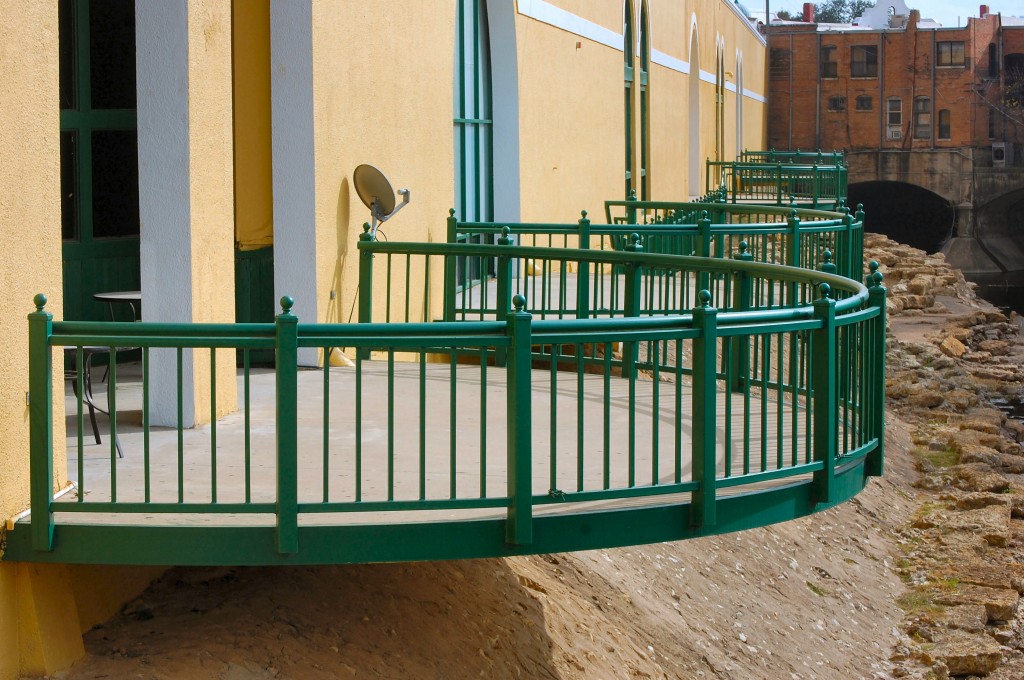
Merchants Exhibits Building (1921) along Marine Creek.
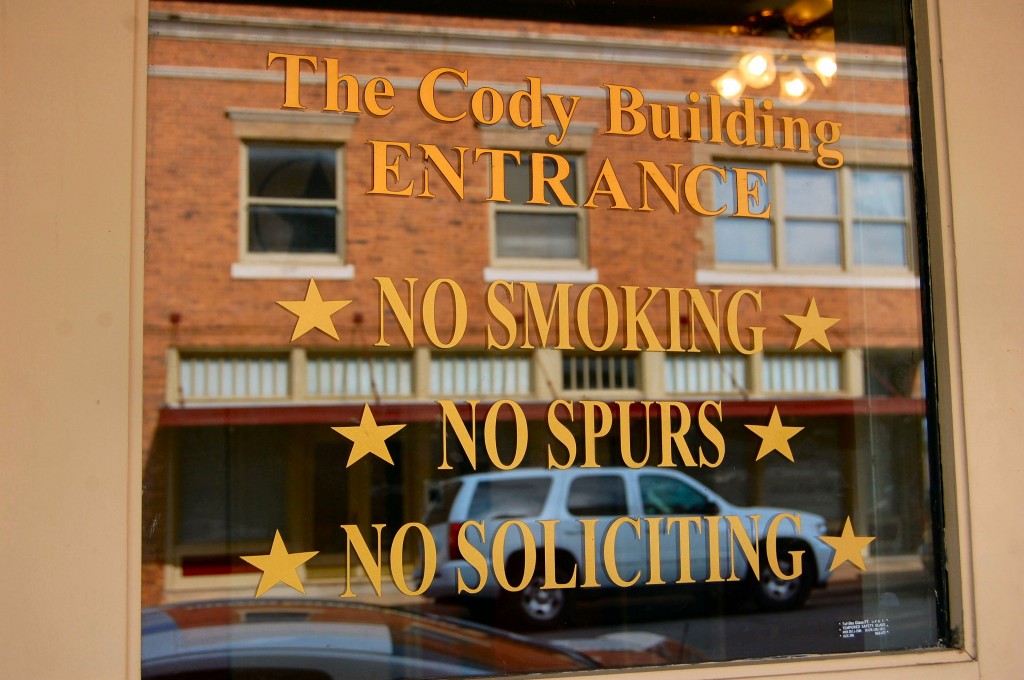
’Nuff said. Cody Building (1908) on Exchange Avenue.
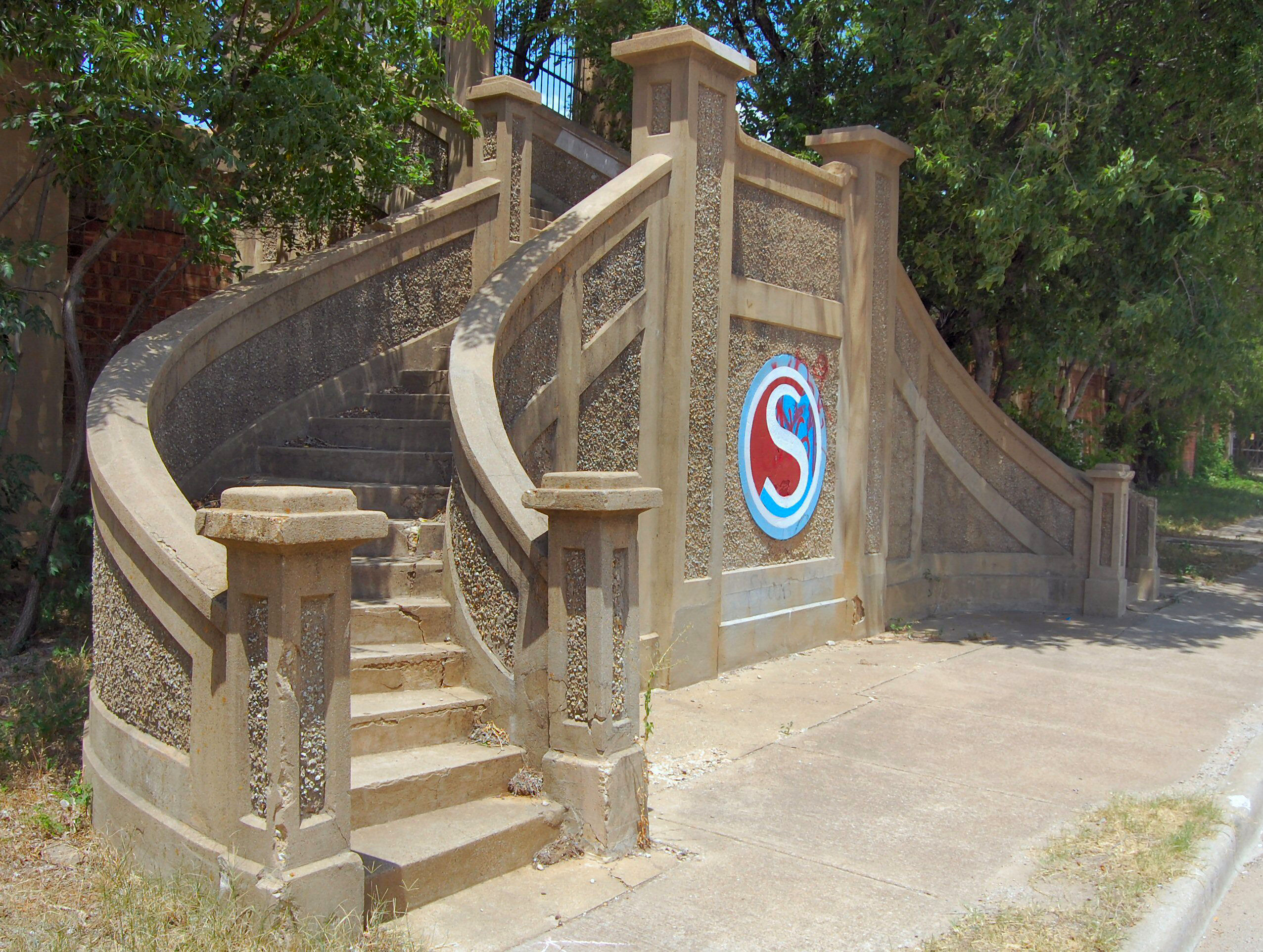

The Swift headquarters (1901) is another historic building now under the stewardship of XTO.
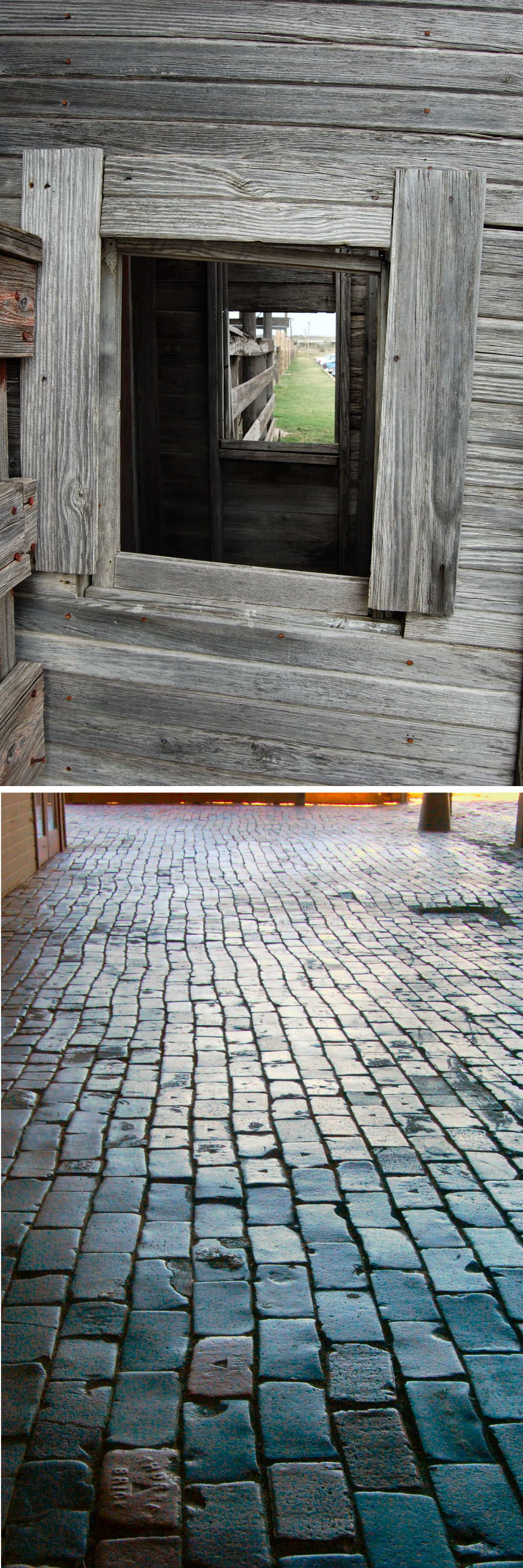
Bricks made in Thurber.
The stockyards and the packing plants, although reduced to a few relics today, are a whole lotta history on the hoof, one of the important “then”s that has led to our “now.” The workers and the animals are gone. Left behind are the wood and the brick—the building materials of a legacy.
A Slow Swift Death (Part 1): The Ghosts of Packers Past
Connections: From Walnut Street to “the Wall Street of the West” (Part 1)






Oh, Mike, I HOPE you’ve had that photo of your grandfather restored!
Sad to say, no. It’s still in two pieces. Been that way as long as I can remember. But a pristine copy exists somewhere because it is reproduced in Mack Williams’s In Old Fort Worth.
Did you ever go in tunnel goes under road?? Will be sad to see the changes coming, started going to Stockyards about 35-36 years ago, so many great little shops (From The Hide), seeing cattle worked in pens..time changes everything, but doesn’t mean we have to like it
John, I have read about the tunnel but never seen it. The Stockyards area, including what is left of the Swift plant, deserves far better.
Nice selection of different views of the Stockyards. It’s also good to see “Thurber” bricks in the last photo — another whole scenario.
Thanks, Bruce. Those bricks are so photogenic.